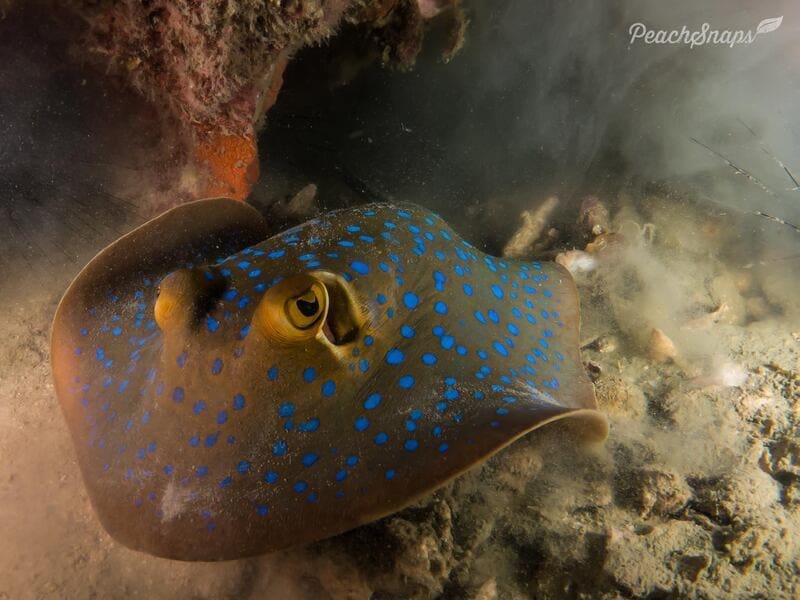The blue-spotted ribbontail ray (Taeniura lymma) is one of the most beautiful and fascinating creatures found in tropical coral reefs. With its vibrant blue spots and long, ribbon-like tail, this ray captivates divers and snorkelers worldwide. Despite its delicate appearance, the blue-spotted ribbontail ray has a venomous sting and should be approached with caution. Let’s explore some intriguing facts, behaviors, and fun encounters with this stunning marine species.

Appearance and Habitat
The blue-spotted ribbontail ray is easily recognized by its distinctive blue spots scattered across its olive-green or brownish body, which grows up to about 14 inches (35 cm) in width, with a tail reaching up to 28 inches (70 cm). The bright blue spots serve as a warning to predators, signaling that this creature has venomous spines on its tail. Its long, thin tail also has characteristic blue stripes, giving it the “ribbontail” name.
These rays are commonly found in the shallow tropical waters of the Indo-Pacific region, from the Red Sea to the coasts of Australia. They prefer sandy bottoms, lagoons, and coral reefs where they can hide under rocks or bury themselves in the sand to ambush prey or avoid predators.
Behavior and Diet
The blue-spotted ribbontail ray is a carnivorous bottom-dweller, feeding mainly on small fish, crabs, and mollusks. Using their flattened bodies, they glide effortlessly over the ocean floor, often uncovering prey hidden in the sand. Their diet plays a vital role in maintaining the health of coral reef ecosystems by controlling populations of smaller species.
A funny and often-shared encounter with these rays involves their shy, yet curious nature. While diving or snorkeling, many have reported these rays quietly following them or hiding behind rocks, only to reappear when the diver isn’t looking. They seem to enjoy playing a game of “peek-a-boo,” cautiously keeping an eye on any unusual underwater visitors.
Are Blue-Spotted Ribbontail Rays Dangerous?
While they are generally non-aggressive and shy, blue-spotted ribbontail rays do have venomous barbs in their tails, which they use for self-defense when threatened. Their sting is painful and can cause injury, but they rarely use it unless provoked or accidentally stepped on. Divers and snorkelers are encouraged to admire them from a distance, and avoid touching or disturbing them. In most cases, they will swim away if they feel uncomfortable or threatened.
In fact, one popular story among divers is of a group snorkeling in shallow waters who, to their surprise, suddenly found themselves surrounded by several blue-spotted rays. The rays, curious but cautious, stayed just out of reach, their vibrant spots shimmering in the sunlight. It was a surreal and peaceful encounter, showing the gentle side of these fascinating creatures.
Conservation and Threats
The blue-spotted ribbontail ray faces several threats, primarily from habitat destruction and overfishing. They are often caught accidentally in fishing nets or targeted for the aquarium trade due to their striking appearance. Additionally, the degradation of coral reefs from pollution and climate change affects their habitat, making conservation efforts critical for their long-term survival.
Although not currently classified as endangered, their declining population in certain regions has raised concern. Protecting coral reefs and implementing sustainable fishing practices are essential steps toward preserving the blue-spotted ribbontail ray and other marine species that rely on these delicate ecosystems.
Why the Blue-Spotted Ribbontail Ray Matters
Aside from their obvious beauty, blue-spotted ribbontail rays play a crucial role in maintaining the health of coral reef environments. Their predation helps control the populations of smaller creatures, ensuring a balanced ecosystem. For divers and marine life enthusiasts, encountering one of these rays is a highlight of any underwater adventure, offering a glimpse into the vibrant biodiversity of coral reefs.
Final Thoughts
The blue-spotted ribbontail ray is a perfect blend of beauty and caution. With its mesmerizing blue spots and venomous defenses, it is a creature that demands respect but offers an unforgettable experience for those lucky enough to see it in its natural habitat. By learning about and protecting these rays and their coral reef homes, we can ensure that future generations continue to marvel at their brilliance.
Check out our next article about: Box Jellyfish
Frequently Asked Questions About the Blue-Spotted Ribbontail Ray
What is the Blue-Spotted Ribbontail Ray?
The Blue-Spotted Ribbontail Ray (Taeniura lymma) is a small, vibrantly colored stingray known for its electric blue spots and ribbon-like tail. It inhabits the warm, shallow waters of the Indo-Pacific region, often seen gliding gracefully over coral reefs and sandy bottoms.
Where can the Blue-Spotted Ribbontail Ray be found?
This species is widely distributed across the tropical Indo-Pacific, from the Red Sea and East Africa to the Solomon Islands and northern Australia. They are commonly found in coral reefs, lagoons, and sandy flats, typically at depths up to 30 meters.
What does the Blue-Spotted Ribbontail Ray eat?
As a carnivorous bottom-dweller, it feeds on small fish, crabs, mollusks, and worms. Using its flattened body, the ray glides over the ocean floor, uncovering prey hidden in the sand.
Is the Blue-Spotted Ribbontail Ray dangerous to humans?
While generally shy and non-aggressive, the ray possesses venomous barbs on its tail used for self-defense. Stings can be painful and potentially harmful, so it’s advisable to observe these creatures from a respectful distance.
How does the Blue-Spotted Ribbontail Ray reproduce?
This species is ovoviviparous, meaning embryos develop inside eggs that remain within the mother’s body until they hatch. Females give birth to up to seven live young, each already displaying the characteristic blue spots.
What is the conservation status of the Blue-Spotted Ribbontail Ray?
The International Union for Conservation of Nature (IUCN) lists the species as Near Threatened, primarily due to habitat degradation and fishing pressures. Conservation efforts are essential to protect their natural habitats and populations.
Can the Blue-Spotted Ribbontail Ray be kept in aquariums?
Although their striking appearance makes them popular in the aquarium trade, they are challenging to maintain in captivity. Many individuals refuse to feed and may not survive long-term in home aquariums.
What role does the Blue-Spotted Ribbontail Ray play in the ecosystem?
By preying on various invertebrates and small fish, they help maintain the balance of reef ecosystems. Their foraging behavior also contributes to the health of the benthic environment.
Are there any unique behaviors exhibited by the Blue-Spotted Ribbontail Ray?
Unlike many stingrays, they rarely bury themselves completely in the sand. At night, they often form small groups to forage in shallow sandy areas, displaying social feeding behaviors.
What are the main threats facing the Blue-Spotted Ribbontail Ray?
Major threats include habitat destruction due to coastal development, pollution, and destructive fishing practices. Additionally, they are often caught as bycatch or collected for the aquarium trade.


Leave a Reply